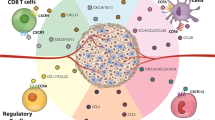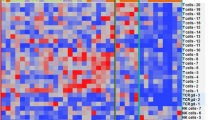Abstract
Multiple myeloma (MM) is a B cell tumor characterized by its selective localization in the bone marrow. The mechanisms that contribute to the multiple myeloma cell recruitment to the bone marrow microenvironment are not well understood. Chemokines play a central role for lymphocyte trafficking and homing. In this study we have investigated expression and functional importance of chemokine receptors in MM-derived cell lines and primary MM cells. We found that MM cell lines express functional CCR1, CXCR3 and CXCR4 receptors, and some also CCR6. Although only a minority of the cell lines responded by calcium mobilization after agonist stimulation, a migratory response to the CCR1 ligands RANTES and MIP-1α was obtained in 5/6 and 4/6, respectively, of the cell lines tested. Five out of six cell lines showed a response to the CXCR4 ligand SDF-1. In addition, 3/6 cell lines migrated in response to MIP-3α and IP-10, ligands for CCR6 and CXCR3, respectively. The expression of CXCR4 and CCR1 and the migration to their ligands, SDF-1, and RANTES and MIP-1α, respectively, were also demonstrated in primary MM cells. These findings suggest that chemokine receptor expression and the migratory capacity of MM cells to their ligands are relevant for the compartmentalization of MM cells in the bone marrow.
This is a preview of subscription content, access via your institution
Access options
Subscribe to this journal
Receive 12 print issues and online access
$259.00 per year
only $21.58 per issue
Buy this article
- Purchase on Springer Link
- Instant access to full article PDF
Prices may be subject to local taxes which are calculated during checkout





Similar content being viewed by others
References
Bakkus, MH, Heirman, C, Van Riet, I, Van Camp, B & Thielemans, K Evidence that multiple myeloma Ig heavy chain VDJ genes contain somatic mutations but show no intraclonal variation. Blood, (1992). 80, 2326–2335.
Baggiolini, M Chemokines and leukocyte traffic. Nature, (1998). 392, 565–568.
Mackay, CR Chemokines: immunology's high impact factors. Nat Immunol, (2001). 2, 95–101.
Kim, CH & Broxmeyer, HE Chemokines: signal lamps for trafficking of T and B cells for development and effector function. J Leukoc Biol, (1999). 65, 6–15.
Moser, B & Loetscher, P Lymphocyte traffic control by chemokines. Nat Immunol, (2001). 2, 123–128.
Bowman, EP, Campbell, JJ, Soler, D, Dong, Z, Manlongat, N, Picarella, D, Hardy, RR & Butcher, EC Developmental switches in chemokine response profiles during B cell differentiation and maturation. J Exp Med, (2000). 191, 1303–1318.
D'Apuzzo, M, Rolink, A, Loetscher, M, Hoxie, JA, Clark-Lewis, I, Melchers, F, Baggiolini, M & Moser, B The chemokine SDF-1, stromal cell-derived factor 1, attracts early stage B cell precursors via the chemokine receptor CXCR4. Eur J Immunol, (1997). 27, 1788–1793.
Forster, R, Mattis, AE, Kremmer, E, Wolf, E, Brem, G & Lipp, M A putative chemokine receptor, BLR1, directs B cell migration to defined lymphoid organs and specific anatomic compartments of the spleen. Cell, (1996). 87, 1037–1047.
Legler, DF, Loetscher, M, Roos, RS, ClarkLewis, I, Baggiolini, M & Moser, B B cell-attracting chemokine 1, a human CXC chemokine expressed in lymphoid tissues, selectively attracts B lymphocytes via BLR1/CXCR5. J Exp Med, (1998). 187, 655–660.
Frade, JM, Mellado, M, del Real, G, Gutierrez-Ramos, JC, Lind, P & Martinez-A, C Characterization of the CCR2 chemokine receptor: functional CCR2 receptor expression in B cells. J Immunol, (1997). 159, 5576–5584.
Baba, M, Imai, T, Nishimura, M, Kakizaki, M, Takagi, S, Hieshima, K, Nomiyama, H & Yoshie, O Identification of CCR6, the specific receptor for a novel lymphocyte-directed CC chemokine LARC. J Biol Chem, (1997). 272, 14893–14898.
Yoshida, R, Imai, T, Hieshima, K, Kusuda, J, Baba, M, Kitaura, M, Nishimura, M, Kakizaki, M, Nomiyama, H & Yoshie, O Molecular cloning of a novel human CC chemokine EBI1- ligand chemokine that is a specific functional ligand for EBI1, CCR7. J Biol Chem, (1997). 272, 13803–13809.
Nagira, M, Imai, T, Yoshida, R, Takagi, S, Iwasaki, M, Baba, M, Tabira, Y, Akagi, J, Nomiyama, H & Yoshie, O A lymphocyte-specific CC chemokine, secondary lymphoid tissue chemokine (SLC), is a highly efficient chemoattractant for B cells and activated T cells. Eur J Immunol, (1998). 28, 16–23.
Krzysiek, R, Lefevre, EA, Bernard, J, Foussat, A, Galanaud, P, Louache, F & Richard, Y Regulation of CCR6 chemokine receptor expression and responsiveness to macrophage inflammatory protein-3alpha/CCL20 in human B cells. Blood, (2000). 96, 2338–2345.
Nagasawa, T, Hirota, S, Tachibana, K, Takakura, N, Nishikawa, S, Kitamura, Y, Yoshida, N, Kikutani, H & Kishimoto, T Defects of B-cell lymphopoiesis and bone-marrow myelopoiesis in mice lacking the CXC chemokine PBSF/SDF-1. Nature, (1996). 382, 635–638.
Ma, Q, Jones, D, Borghesan, PR, Segal, RA, Nagasawa, T, Kishimoto, T, Bronson, R & Springer, TA Impaired B-lymphopoiesis, myelopoiesis, and derailed cerebellar neuron migration in CXCR4- and SDF-1-deficient mice. Proc Natl Acad Sci USA, (1998). 95, 9448–9453.
Tashiro, K, Tada, H, Heilker, R, Shirozu, M, Nakano, T & Honjo, T Signal sequence trap: a cloning strategy for secreted proteins and type I membrane proteins. Science, (1993). 261, 600–603.
Bleul, CC, Fuhlbrigge, RC, Casasnovas, JM, Aiuti, A & Springer, TA A highly efficacious lymphocyte chemoattractant, stromal cell-derived factor 1 (SDF-1). J Exp Med, (1996). 184, 1101–1109.
Ma, Q, Jones, D & Springer, TA The chemokine receptor CXCR4 is required for the retention of B lineage and granulocytic precursors within the bone marrow microenvironment. Immunity, (1999). 10, 463–471.
Bleul, CC, Schultze, JL & Springer, TA B lymphocyte chemotaxis regulated in association with microanatomic localization, differentiation state, and B cell receptor engagment. J Exp Med, (1998). 187, 753–762.
Honczarenko, M, Douglas, RS, Mathias, C, Lee, B, Ratajczak, MZ & Silberstein, LE SDF-1 responsiveness does not correlate with CXCR4 expression levels of developing human bone marrow B cells. Blood, (1999). 94, 2990–2998.
Wehrli, N, Legler, DF, Finke, D, Toellner, KM, Loetscher, P, Baggiolini, M, MacLennan, IC & Acha-Orbea, H Changing responsiveness to chemokines allows medullary plasmablasts to leave lymph nodes. Eur J Immunol, (2001). 31, 609–616.
Dürig, J, Schmucker, U & Duhrsen, U Differential expression of chemokine receptors in B cell malignancies. Leukemia, (2001). 15, 752–756.
Nilsson, K, Bennich, H, Johansson, S & Ponten, J Established immunoglobulin producing myeloma (IgE) and lymphoblastoid (IgG) cell line from an IgE myeloma patient. Clin Exp Immunol, (1970). 7, 477–489.
Hellman, L, Josephson, S, Jernberg, H, Nilsson, K & Pettersson, U Immunoglobulin synthesis in the human myeloma cell line U-266; expression of two immunoglobulin heavy chain isotypes (epsilon and alpha) after long-term cultivation in vitro. Eur J Immunol, (1988). 18, 905–910.
Jernberg, H, Nilsson, K, Zech, L, Lutz, D, Nowotny, H & Scheirer, W Establishment and phenotypic characterization of three new human myeloma celll lines (U-1957, U-1958, and U-1996). Blood, (1987). 69, 1605–1612.
Karpas, A, Fischer, P & Swirsky, D Human myeloma cell line carrying a Philadelphia chromosome. Science, (1982). 216, 997–999.
Pegoraro, L, Malavasi, F, Belloni, G, Massaia, M, Boccadoro, M, Saglio, G, Guerrasio, A, Benetton, G, Lombardi, L, Coda, R & Avanzi, G The human myeloma cell lineLP-1: versatile model in which to study early plasma cell differentiation and c-myc activation. Blood, (1989). 73, 1020–1027.
Diehl, V, Schaadt, M, Kirchner, H, Hellriegel, KP, Gudat, F, Fonatsch, C, Laskewitz, E & Guggenheim, R Long-term cultivation of plasma cell leukemia cells and autologous lymphoblasts (LCL) in vitro: a comparative study. Blut, (1978). 36, 331–338.
Scibienski, RJ, Paglieroni, T, Caggiano, V, Lemongello, D, Gumerlock, PH & Mackenzie, MR Factors affecting the in vitro evolution of a myeloma cell line. Leukemia, (1992). 6, 940–947.
Jernberg-Wiklund, H & Nilsson, K Plasma cell and myeloma cell lines. In: Masters JRW, Palsson B (eds)Human cell culture, 3, Kluwer Academic Publishers: Dordrecht (2000). pp81–155.
Juremalm, M, Hjertson, M, Olsson, N, Harvima, I, Nilsson, K & Nilsson, G The chemokine receptor CXCR4 is expressed within the mast cell lineage and its ligand SDF-1α acts as a mast cell chemotaxin. Eur J Immunol, (2000). 30, 3614–3622.
Frevert, CW, Wong, VA, Goodman, RB, Goodwin, R & Martin, TR Rapid fluorescence-based measurement of neutrophil migration in vitro. J Immunol Methods, (1998). 213, 41–52.
Rabin, RL, Park, MK, Liao, F, Swofford, R, Stephany, D & Farber, JM Chemokine receptor responses on T cells are achieved through regulation of both receptor expression and signaling. J Immunol, (1999). 162, 3840–3850.
Hargreaves, DC, Hyman, PL, Lu, TT, Ngo, VN, Bidgol, A, Suzuki, G, Zou, YR, Littman, DR & Cyster, JG A coordinated change in chemokine responsiveness guides plasma cell movements. J Exp Med, (2001). 194, 45–56.
Su, SB, Mukaida, N, Wang, J, Nomura, H & Matsushima, K Preparation of specific polyclonal antibodies to a C-C chemokine receptor, CCR1, and determination of CCR1 expression on various types of leukocytes. J Leukoc Biol, (1996). 60, 658–666.
Choi, SJ, Cruz, JC, Craig, F, Chung, H, Devlin, RD, Roodman, GD & Alsina, M Macrophage inflammatory protein 1-alpha is a potential osteoclast stimulatory factor in multiple myeloma. Blood, (2000). 96, 671–675.
Qin, SX, Rottman, JB, Myers, P, Kassam, N, Weinblatt, M, Loetscher, M, Koch, AE, Moser, B & Mackay, CR The chemokine receptors CXCR3 and CCR5 mark subsets of T cells associated with certain inflammatory reactions. J Clin Invest, (1998). 101, 746–754.
Piali, L, Weber, C, LaRosa, G, Mackay, CR, Springer, TA, Clark-Lewis, I & Moser, B The chemokine receptor CXCR3 mediates rapid and shear-resistant adhesion-induction of effector T lymphocytes by the chemokines IP10 and Mig. Eur J Immunol, (1998). 28, 961–972.
Loetscher, M, Loetscher, P, Brass, N, Meese, E & Moser, B Lymphocyte-specific chemokine receptor CXCR3: regulation, chemokine binding and gene localization. Eur J Immunol, (1998). 28, 3696–3705.
Sallusto, F, Lenig, D, Mackay, CR & Lanzavecchia, A Lymphocyte-specific chemokine receptor CXCR3: regulation, chemokine binding and gene localization. J Exp Med, (1998). 187, 875–883.
Jones, D, Benjamin, RJ, Shahsafaei, A & Dorfman, DM The chemokine receptor CXCR3 is expressed in a subset of B-cell lymphomas and is a marker of B-cell chronic lymphocytic leukemia. Blood, (2000). 95, 627–632.
Trentin, L, Agostini, C, Facco, M, Piazza, F, Perin, A, Siviero, M, Gurrieri, C, Galvan, S, Adami, F, Zambello, R & Semenzato, G The chemokine receptor CXCR3 is expressed on malignant B cells and mediates chemotaxis. J Clin Invest, (1999). 104, 115–121.
Fedyk, ER, Ryyan, D, Ritterman, I & Springer, TA Maturation decreases responsiveness of human bone marrow B lineage cells to stromal-derived factor 1 (SDF-1). J Leukoc Biol, (1999). 66, 667–673.
Vicente-Manzanares, M, Montoya, MC, Mellado, M, Frade, JM, del Pozo, MA, Nieto, M, de Landazuri, MO, Martinez-A, C & Sanchez-Madrid, F The chemokine SDF-1alpha triggers a chemotactic response and induces cell polarization in human B lymphocytes. Eur J Immunol, (1998). 29, 2197–2207.
Acknowledgements
We thank Drs Karl Åkerman and Jyrki Kukkonen for help with [Ca2+]i-analysis and Dr A Österborg, Karolinska Hospital, Stockholm, for providing the MM tumour samples. This work was supported by grants from the Swedish Cancer Society, Hans von Kantzow's Foundation, Ollie and Elof Ericsson's foundation, Erik, Karin and Gösta Selander's Foundation, and Göran Gustafsson's Foundation.
Author information
Authors and Affiliations
Rights and permissions
About this article
Cite this article
Möller, C., Strömberg, T., Juremalm, M. et al. Expression and function of chemokine receptors in human multiple myeloma. Leukemia 17, 203–210 (2003). https://doi.org/10.1038/sj.leu.2402717
Received:
Accepted:
Published:
Issue Date:
DOI: https://doi.org/10.1038/sj.leu.2402717
Keywords
This article is cited by
-
Alcohol consumption promotes colorectal carcinoma metastasis via a CCL5-induced and AMPK-pathway-mediated activation of autophagy
Scientific Reports (2018)
-
Autologous bone marrow Th cells can support multiple myeloma cell proliferation in vitro and in xenografted mice
Leukemia (2017)
-
EphA3 targeting reduces in vitro adhesion and invasion and in vivo growth and angiogenesis of multiple myeloma cells
Cellular Oncology (2017)
-
The chemokines CCR1 and CCRL2 have a role in colorectal cancer liver metastasis
Tumor Biology (2016)
-
Global methylation profiling to identify epigenetic signature of gallbladder cancer and gallstone disease
Tumor Biology (2016)



